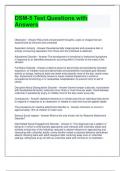DSM-5 Test Questions with
Answers
Obsession - Answer-Recurrent and persistent thoughts, urges or images that are
experienced as intrusive and unwanted
Separation Aniexty - Answer-Developmentally inappropriate and excessive fear or
anxiety concerning separation from those who the individual is attached.
Adjustment Disorder - Answer-The development of emotional or behavioral symptoms
in response to an identified stressor(s) occurring within 3 months of the onset of the
stressor.
Full Manic Episode - Answer-a distinct period of abnormally and persistently elevated,
expansive, or irritable mood and abnormally and persistently increased goal-directed
activity or energy, lasting at least one week and presently most of the day, nearly every
day. Impairment is sufficiently severe to cause marked impairment in social or
occupational functioning or to necessitate hospitalization to prevent harm to self of
others.
Disruptive Mood Disregulation Disorder - Answer-Severe temper outbursts, inconsistent
with developmental levels, outbursts occur three or more time per week, mood between
outbursts in persistently angry or irritable most of the day nearly every day.
Compulsions - Answer-repetitive behaviors or mental acts that an individual feels driven
to respond in response to an obsession or related to rules that must be applied rigidly.
The prevalence for reactive attachment disorder is - Answer-Unknown or occurs in
approximately 10% of children in foster care.
Serious Social neglect - Answer-What is the only known risk for Reactive Attachment
Disorder?
Disinhibited Social Engagement Disorder - Answer-C. This diagnosis has a pattern of
behavior in which a child actively approaches and interacts with unfamiliar adults and
exhibits at least two of the following: reduced or absent reticence in approaching and
interacting with unfamiliar adults, overly familiar verbal or physical behavior diminished
absent checking back with adult caregiver after venturing away even in unfamiliar
settings, willingness to go off with an unfamiliar adult with minimal or no hesitation.
, The prevalence for Disinhibited Social Engagement Disorder is - Answer-Unknown or
occurs in approximately 20% of children in foster care.
The prevalence of PTSD, projected lifetime risk by age 75 years is: - Answer-8.75%
Generalized anxiety disorder - Answer-C. Diagnostic category includes Excessive
anxiety and worry (apprehensive expectation) occurring more days than not for at least
6 months about a number of events or activities (such as work or school performance).
Individual finds it difficult to control the worry, causes clinically significant distress.
Anxiety Disorder due to Another Medical Condition - Answer-D. This diagnosis involves
panic attacks or anxiety, based on evidence from history, physical examination or
laboratory findings, the disturbance is the direct pathophysiological consequence of
another medical condition.
RAD is common in the general population - Answer-False
DSM-5 is controversial because it could expand diagnoses of disorders - Answer-True
Depression is one of the most common disorders - Answer-true
Dissociative Disorders - Answer-These disorders are frequently found in the aftermath
of trauma, and many of the symptoms, including embarrassment and confusion about
the symptoms or desire to hide them, are influenced by the proximity to the trauma.
Dissociative Amnesia - Answer-An inability to recall important autobiographical
information, usually of a traumatic or stressful nature, that is inconsistent with ordinary
forgetting Note: Dissociative amnesia most often consists of localized or selective
amnesia for a specific event or events; generalized amnesia for identity and life history.
Depersonalization/Derealization Disorder - Answer-The presence of persistent or
recurrent experiences of depersonalization, derealization or both:
1. depersonalization: experiences of unreality, detachment, or being an outside
observer with respect to one's thoughts, feelings, sensations, body or actions (e.g.
perceptual alterations, distorted sense of time, unreal or absent self, emotional or
physical numbing).
2. derealization: experiences of unreality or detachment with respect to surroundings
(e.g. individuals or objects are experienced as unreal, dreamlike, foggy, lifeless or
visually distorted).
Pica - Answer-the essential feature of pica is the eating of one or more nonnutritive,
nonfood substances on a persistent basis over a period of at least 1 month (Criterion A)
that is severe enough to warrant clinical attention. Typical substances ingested tend to
vary with age and availability and might include paper, soap, cloth, hair, string, wool,
soil, chalk, talcum powder, paint, gum, metal, pebbles, charcoal or coal, ash, clay,




